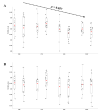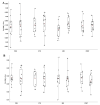Corticomuscular Coherence and Motor Control Adaptations after Isometric Maximal Strength Training
- PMID: 33670532
- PMCID: PMC7922221
- DOI: 10.3390/brainsci11020254
Corticomuscular Coherence and Motor Control Adaptations after Isometric Maximal Strength Training
Abstract
Strength training (ST) induces corticomuscular adaptations leading to enhanced strength. ST alters the agonist and antagonist muscle activations, which changes the motor control, i.e., force production stability and accuracy. This study evaluated the alteration of corticomuscular communication and motor control through the quantification of corticomuscular coherence (CMC) and absolute (AE) and variable error (VE) of the force production throughout a 3 week Maximal Strength Training (MST) intervention specifically designed to strengthen ankle plantarflexion (PF). Evaluation sessions with electroencephalography, electromyography, and torque recordings were conducted pre-training, 1 week after the training initiation, then post-training. Training effect was evaluated over the maximal voluntary isometric contractions (MVIC), the submaximal torque production, AE and VE, muscle activation, and CMC changes during submaximal contractions at 20% of the initial and daily MVIC. MVIC increased significantly throughout the training completion. For submaximal contractions, agonist muscle activation decreased over time only for the initial torque level while antagonist muscle activation, AE, and VE decreased over time for each torque level. CMC remained unaltered by the MST. Our results revealed that neurophysiological adaptations are noticeable as soon as 1 week post-training. However, CMC remained unaltered by MST, suggesting that central motor adaptations may take longer to be translated into CMC alteration.
Keywords: EEG; EMG; plantarflexion; training performances.
Conflict of interest statement
The authors declare no conflict of interest.
Figures










Similar articles
-
Effect of the phase of force production on corticomuscular coherence with agonist and antagonist muscles.Eur J Neurosci. 2018 Nov;48(10):3288-3298. doi: 10.1111/ejn.14126. Epub 2018 Oct 10. Eur J Neurosci. 2018. PMID: 30141828
-
Effect of training status on beta-range corticomuscular coherence in agonist vs. antagonist muscles during isometric knee contractions.Exp Brain Res. 2017 Oct;235(10):3023-3031. doi: 10.1007/s00221-017-5035-z. Epub 2017 Jul 19. Exp Brain Res. 2017. PMID: 28725924
-
Impaired corticomuscular coherence during isometric elbow flexion contractions in humans with cervical spinal cord injury.Eur J Neurosci. 2017 Aug;46(4):1991-2000. doi: 10.1111/ejn.13641. Epub 2017 Aug 1. Eur J Neurosci. 2017. PMID: 28699218
-
Neural adaptations to resistive exercise: mechanisms and recommendations for training practices.Sports Med. 2006;36(2):133-49. doi: 10.2165/00007256-200636020-00004. Sports Med. 2006. PMID: 16464122 Review.
-
Influencing factors of corticomuscular coherence in stroke patients.Front Hum Neurosci. 2024 Mar 18;18:1354332. doi: 10.3389/fnhum.2024.1354332. eCollection 2024. Front Hum Neurosci. 2024. PMID: 38562230 Free PMC article. Review.
Cited by
-
Intermuscular coherence of plantar and dorsiflexor muscles in older adults with Parkinson's disease and age-matched controls during bipedal and unipedal stance.Front Aging Neurosci. 2023 Feb 20;15:1093295. doi: 10.3389/fnagi.2023.1093295. eCollection 2023. Front Aging Neurosci. 2023. PMID: 36891558 Free PMC article.
-
Assessing Cognitive Workload in Motor Decision-Making through Functional Connectivity Analysis: Towards Early Detection and Monitoring of Neurodegenerative Diseases.Sensors (Basel). 2024 Feb 7;24(4):1089. doi: 10.3390/s24041089. Sensors (Basel). 2024. PMID: 38400247 Free PMC article.
-
The neuromechanical of Beta-band corticomuscular coupling within the human motor system.Front Neurosci. 2024 Aug 15;18:1441002. doi: 10.3389/fnins.2024.1441002. eCollection 2024. Front Neurosci. 2024. PMID: 39211436 Free PMC article. Review.
-
Comparison of corticomuscular coherence under different balance paradigms in individuals with and without forward head posture.Sci Rep. 2025 Jul 2;15(1):22985. doi: 10.1038/s41598-025-06603-8. Sci Rep. 2025. PMID: 40594912 Free PMC article.
-
Brain-hemispheric differences in the premotor area for motor planning: An approach based on corticomuscular connectivity during motor decision-making.Neuroimage. 2025 May 15;312:121230. doi: 10.1016/j.neuroimage.2025.121230. Epub 2025 Apr 17. Neuroimage. 2025. PMID: 40252879 Free PMC article.
References
LinkOut - more resources
Full Text Sources
Other Literature Sources

